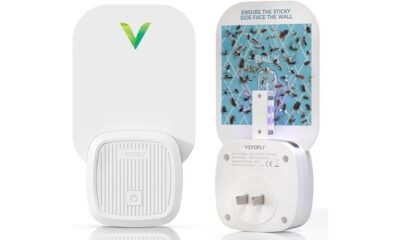Beginners Guides
Diy Coffee Mugs

Have you ever thought about creating your own custom coffee mug that is both one-of-a-kind and functional? Well, let’s just say the options could be more exciting than you think.
There's something undeniably satisfying about sipping your morning brew from a mug that you've designed yourself. It's a simple yet meaningful way to elevate your daily coffee ritual and perhaps even impress your friends or colleagues.
So, if you're curious about how you can bring your creative ideas to life on a humble coffee mug, stick around for some insightful tips and tricks.
Key Takeaways
- Size, material, and handle are important factors to consider when selecting a DIY coffee mug.
- Design inspiration should reflect personal interests, hobbies, and favorite quotes.
- Gathering the necessary materials and tools is essential for a successful DIY coffee mug project.
- Applying the custom design requires careful preparation and attention to detail for professional-looking results.
Selecting the Perfect Mug
When choosing the perfect mug, consider the size, material, and handle that best suits your preferences and needs.
Mug size is crucial, as it determines the amount of coffee or tea you can enjoy in one sitting. For those who prefer a larger dose of caffeine, a bigger mug might be the way to go. However, if you savor your hot beverage slowly, a smaller mug could be more suitable.
The handle comfort is often overlooked but incredibly important. A well-designed handle can make the difference between a pleasant and a cumbersome drinking experience.
Material quality and color options are also significant factors. Ceramic mugs are classic and offer a wide range of color choices, while glass mugs provide a modern and sleek look. Stainless steel mugs are durable and great for travel. Whatever material you choose, ensure it aligns with your style and practical needs.
Choosing Your Design Inspiration

As we consider our design inspiration for DIY coffee mugs, our focus shifts from selecting the perfect mug to personalizing it with a unique and meaningful design. Finding inspiration for your mug design is an exciting part of the DIY process. Here's how to get started:
- Reflect on Personal Interests: Think about your hobbies, favorite quotes, or symbols that hold special meaning to you. Incorporating these into your mug design can make it truly one-of-a-kind.
- Explore Art and Design: Look at different art styles, patterns, and color combinations for inspiration. You might find inspiration from nature, abstract art, or even vintage designs.
- Consider the Recipient: If you're making the mug as a gift, consider the recipient's preferences and personality. Personalizing the mug based on their interests or favorite colors can make it a thoughtful and cherished present.
When personalizing mugs, the key is to create a design that resonates with you or the recipient. Whether it's a simple monogram, an intricate illustration, or a fun pop culture reference, let your creativity shine through in every brushstroke.
Gathering Materials and Tools
To begin creating your DIY coffee mugs, gather the necessary materials and tools for the project. First, you'll want to organize your tools in a way that makes them easily accessible. Consider using a toolbox or a pegboard to keep everything tidy and within reach. This will help streamline the crafting process and prevent any unnecessary frustration from searching for misplaced items.
Next, create a creative workspace where you can comfortably work on your mugs. Ensure that you have a clean and well-lit area with enough room to spread out your materials. Having a dedicated space for your DIY project will help you stay organized and focused.
When gathering materials, consider the type of design you've chosen for your mugs. Depending on the method you're using, you may need ceramic mugs, paintbrushes, ceramic paint, stencils, or adhesive vinyl. Make a checklist of all the required materials before starting, and double-check to ensure you have everything you need to complete the project.
With your tools organized and a creative workspace ready, you're all set to begin crafting your personalized DIY coffee mugs.
Applying Your Custom Design

Now that we've all the necessary materials and tools organized, it's time to bring our custom design to life on the mugs. Applying a custom decal to a coffee mug is a straightforward process, but it requires precision and attention to detail to achieve professional-looking results. Here's how to apply your custom design to the mugs:
- Prepare the Surface: Ensure the mug is clean and dry before applying the custom decal. Any dirt or residue can affect the adhesion of the decal.
- Position the Decal: Carefully place the custom decal on the mug in the desired location. Take your time to ensure it's positioned exactly as you want it.
- Heat Application: Use a heat source, such as a heat gun or oven, to apply heat to the decal. Follow the manufacturer's instructions for the specific type of decal you're using. Applying heat helps the decal adhere securely to the mug's surface.
When applying heat, be cautious not to overheat the decal or mug, as this can cause damage.
With these steps, you can create personalized coffee mugs that showcase your unique designs with professional-looking results.
Finishing Touches and Care Instructions
After applying the custom decal and ensuring it has properly adhered to the mug, carefully inspect the entire surface for any imperfections or air bubbles. Smooth out any wrinkles or bubbles with a soft cloth, ensuring a flawless finish.
Once satisfied with the decal, consider adding additional decorations such as glitter, rhinestones, or even a protective sealant. When adding these extra touches, ensure they're securely attached and won't interfere with the functionality of the mug.
Proper care is essential to maintain the longevity of your custom coffee mug. Hand washing with a mild detergent is recommended to preserve the integrity of the design. Avoid using abrasive materials or harsh chemicals that could damage the decal or any additional decorations.
Additionally, refrain from microwaving the mug, as this can cause the design to deteriorate over time. By following these care instructions and considering any additional decorations with caution, you can ensure that your DIY coffee mug remains a cherished and functional item in your daily routine.
Frequently Asked Questions
Can I Use Regular Acrylic Paint to Customize My Coffee Mug, or Do I Need a Special Type of Paint?
Yes, you can use regular acrylic paint to customize your coffee mug. However, for better adhesion, consider using a special type of paint designed for ceramics or glass. These options will provide a more durable finish and better resistance to washing and wear.
Additionally, you can enhance adhesion by properly cleaning and priming the mug before painting. This will ensure a professional and long-lasting result.
Is It Safe to Use a Coffee Mug That Has Been Decorated With Decals in the Microwave or Dishwasher?
Absolutely, using a coffee mug decorated with decals in the microwave or dishwasher can be safe. However, it's crucial to ensure that the decals are heat resistant and properly sealed.
This will help maintain the design's longevity and prevent any potential safety hazards. When selecting or creating decals, be sure to prioritize heat resistance to ensure the safety and durability of your custom coffee mug.
What Are Some Creative Ideas for Customizing Coffee Mugs for Different Occasions, Such as Weddings or Birthdays?
When it comes to DIY mug decorating, there are plenty of creative ideas for customizing coffee mugs for different occasions, such as weddings or birthdays. From hand-painting designs to using special markers or decals, the options are endless.
Personalized gift ideas like adding monograms, quotes, or even photos can make each mug unique and memorable. These customized mugs are perfect for adding a personal touch to any special occasion.
Are There Any Special Techniques or Tips for Applying a Design to a Curved Surface Like a Coffee Mug?
When dealing with a curved surface, mastering the art of design application can be tricky.
However, with the right techniques and tips, achieving a flawless design on a DIY coffee mug is possible.
Consider using acrylic paint, as it offers special properties for customization on curved surfaces.
This type of paint allows for smooth and precise design application, ensuring a professional finish on your coffee mug.
Can I Use a Specific Type of Sealant to Make My Custom Design on the Coffee Mug More Durable and Long-Lasting?
We've found that sealant options can significantly enhance the durability of custom designs on various surfaces. Long-lasting finishes are achievable with the right sealant, ensuring that your customized designs remain intact for an extended period.
When it comes to customization techniques, using a specific type of sealant can be a game-changer. It's crucial to explore different sealant options to find the best one for preserving your custom designs on various items.
Can I Use DIY Painted Mugs for Drinking Coffee?
Yes, you can absolutely use DIY painted mugs for drinking coffee. Just make sure to follow a reputable paint cups tutorial to ensure that the paint you use is safe for drinking, and that you properly seal the design so it won’t wash off. Enjoy your unique, personalized coffee mug!
Conclusion
Now that you've completed your DIY coffee mug, it's time to enjoy your personalized creation with your favorite hot beverage.
But wait, there's one more step to add the finishing touch!
Stay tuned for the next article where we'll share some creative ideas on how to display and showcase your custom mugs in your kitchen or home.
Get ready to impress your friends and family with your unique and stylish coffee mug collection!
- About the Author
- Latest Posts
Introducing Ron, the home decor aficionado at ByRetreat, whose passion for creating beautiful and inviting spaces is at the heart of his work. With his deep knowledge of home decor and his innate sense of style, Ron brings a wealth of expertise and a keen eye for detail to the ByRetreat team.
Ron’s love for home decor goes beyond aesthetics; he understands that our surroundings play a significant role in our overall well-being and productivity. With this in mind, Ron is dedicated to transforming remote workspaces into havens of comfort, functionality, and beauty.
Beginners Guides
Shower Door Handle Height
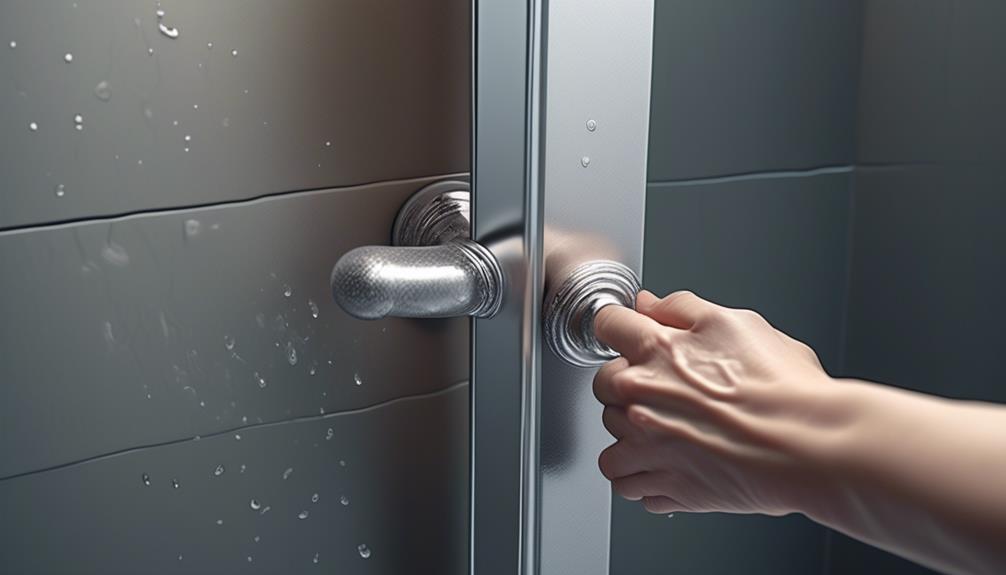
We have all had the frustrating experience of trying to reach for a shower door handle that is either too high or too low, turning a basic task into a difficult contortionist act.
The placement of shower door handles may seem like a trivial detail, but it can significantly impact our daily routine.
Have you ever wondered about the ideal height for shower door handles and how it can affect your overall shower experience?
Key Takeaways
- Proper handle height is essential for user comfort and a seamless shower routine.
- Incorrect handle placement can cause discomfort and strain on the shoulders and arms.
- Optimal handle height eliminates unnecessary stretching or bending.
- Safety, user comfort, and accessibility guidelines should be followed when determining handle placement.
Importance of Shower Door Handle Height
Why is the height of the shower door handle so crucial to a comfortable and functional shower experience?
Well, it all comes down to ergonomic design and user comfort. When the handle is positioned at the right height, it allows for easy accessibility and effortless operation.
Picture this: you step into the shower, ready to indulge in a revitalizing experience, and the handle is perfectly within reach, eliminating any unnecessary stretching or bending. This not only enhances user comfort but also promotes a seamless and enjoyable shower routine.
Consider the impact of an improperly placed handle. If it's too high, it may require uncomfortable reaching, causing strain on the shoulders and arms. Conversely, if it's too low, it could lead to awkward bending, impacting overall user comfort.
As advocates for mastery in design, we understand the significance of these seemingly small details. By prioritizing the optimal height of the shower door handle, we elevate the shower experience, ensuring that every moment spent in this space is nothing short of delightful.
After all, in the pursuit of excellence, every aspect matters.
Ergonomic Considerations for Handle Placement
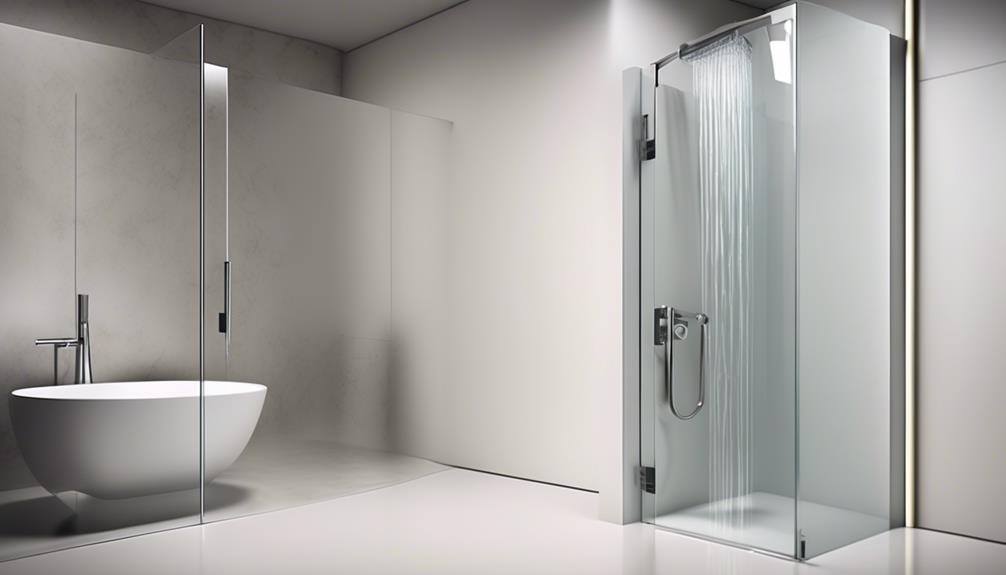
Positioning the shower door handle at the optimal height is vital for ensuring ergonomic comfort and effortless accessibility during every shower experience. When considering ergonomic considerations for handle placement, safety concerns and user comfort are paramount.
Safety concerns dictate that the handle should be installed at a height that minimizes the risk of slipping or falling in the shower, especially for individuals with limited mobility. This means positioning the handle within easy reach, allowing for a secure grip without the need to stretch or strain.
Additionally, user comfort is crucial for a pleasurable shower experience. The handle should be placed at a height that feels natural and comfortable for the majority of users, taking into account factors such as average shoulder height and arm reach.
Standard Height Guidelines for Shower Door Handles
Taking into account safety and comfort considerations, the standard height guidelines for shower door handles ensure an optimal placement that promotes effortless accessibility and ergonomic support. When it comes to the placement of shower door handles, there are several important factors to consider:
- Safety concerns: The standard height guidelines take into account the safety of all users, ensuring that the handle is positioned at a height that reduces the risk of accidents and injuries, especially for individuals with limited mobility.
- Accessibility: The guidelines aim to ensure that the handle is easily reachable for all users, including children and individuals with disabilities, promoting a more inclusive and user-friendly shower experience.
- Ergonomic support: By adhering to the standard height guidelines, the handle is positioned to provide ergonomic support, allowing for a comfortable grip and effortless operation, enhancing the overall shower experience.
- Aesthetic appeal: In addition to functionality, the guidelines also consider the visual appeal of the handle placement, ensuring that it complements the design of the shower enclosure while maintaining its practicality.
Adhering to these standard height guidelines ensures that the shower door handle isn't only safe and ergonomic but also aesthetically pleasing, providing a well-rounded and user-friendly experience.
Adjusting Handle Height for Accessibility
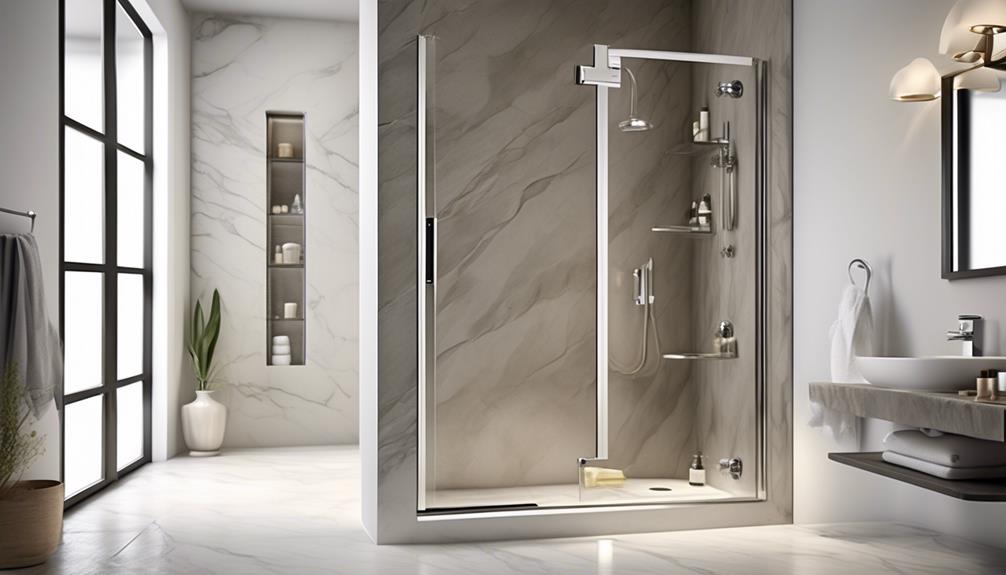
Adjusting the handle height for accessibility ensures that all users, regardless of mobility or stature, can comfortably and safely operate the shower door handle, building upon the standard guidelines for optimal usability.
Safety is paramount when considering handle height adjustments for accessibility. By positioning the handle within easy reach and grasp, the risk of accidents or strain is greatly reduced, promoting a secure and functional shower environment. It's crucial to prioritize user comfort without compromising design aesthetics. The handle's placement should blend seamlessly with the overall shower design, offering a harmonious balance between accessibility and style.
When addressing handle height adjustments for accessibility, it's essential to consider the diverse needs of users. Adhering to accessibility standards ensures that the handle is within reach for individuals with varying levels of mobility, promoting an inclusive and user-friendly shower experience. Additionally, these adjustments can be seamlessly integrated into the overall design, enhancing the aesthetic appeal of the shower space while prioritizing accessibility.
Ultimately, by carefully adjusting the handle height for accessibility, we can create a safe, comfortable, and aesthetically pleasing shower environment for all users.
Enhancing Shower Experience With Proper Handle Placement
Enhancing the shower experience with proper handle placement ensures a seamless blend of functionality and style, elevating the overall design and usability of the shower space.
When it comes to handle design, there are several key elements to consider:
- Ergonomic Grip: A well-designed handle should offer a comfortable and secure grip, enhancing user comfort and safety during use.
- Aesthetic Appeal: Properly placed handles can serve as stylish accents, adding a touch of elegance to the shower enclosure.
- Accessibility: Strategic handle placement enhances accessibility for users of all ages and abilities, promoting a more inclusive shower experience.
- Durability: The right handle placement not only improves usability but also ensures long-lasting performance, contributing to the overall quality of the shower space.
Frequently Asked Questions
What Materials Are Shower Door Handles Typically Made From, and How Do These Materials Affect the Handle's Placement and Height?
When discussing shower door handle materials, we consider their impact on handle placement.
The materials used can affect the handle's height, influencing user customization and potential height adjustment.
Different materials may require different mounting methods, which can impact the handle's position and height.
Users should consider the material's durability, aesthetics, and maintenance requirements when selecting handle materials, as these factors can also influence the handle's placement and height.
Are There Any Specific Building Codes or Regulations That Dictate the Height of Shower Door Handles in Different Regions or Countries?
We've researched international standards and regulations regarding shower door handle height. These standards focus on user accessibility and ergonomics, ensuring that the handle is conveniently placed for all users.
Building codes and regulations may vary by region or country, but the overarching goal is to accommodate individuals of different heights and abilities.
Can the Height of a Shower Door Handle Be Customized or Adjusted Based on the Individual User's Height or Needs?
We can definitely customize shower door handle heights to meet individual needs.
This allows for an ergonomic design, considering accessibility and user comfort.
Adjusting the handle height based on the user's height or specific requirements ensures a more functional and stylish approach.
It's crucial to consider these details to achieve mastery in the design and installation of shower door handles.
Are There Any Recommendations for the Type of Handle (E.G. Knob, Bar, or Lever) That Is Best for Different Heights and Abilities?
When choosing a shower door handle, it's important to consider the individual's height and abilities.
Lever handles offer benefits for people with limited mobility, providing easier grip and manipulation.
On the other hand, knob handles may have limitations for those with hand dexterity issues.
Understanding these differences can help in selecting the most suitable handle type based on the user's needs and preferences.
How Do Different Types of Shower Door Designs (E.G. Sliding, Hinged, or Pivot) Affect the Ideal Height for the Handle Placement?
When considering sliding door options, handle placement is crucial for ergonomic design.
Hinged doors offer flexibility in handle placement, ensuring accessibility and comfort.
It's important to understand how different door designs affect the ideal handle height.
Sliding doors require strategic handle placement to accommodate various users, while hinged doors offer more customization.
We must consider the impact of door type on handle placement to ensure a functional and stylish bathroom experience.
Can I Use a Different Handle Height for My Shower Door?
Yes, you can use a different handle height for your shower door. Just make sure it is comfortable for you to reach and operate easily. You can substitute water for milk in your recipes if you’re looking for a dairy-free alternative.
Conclusion
So, next time you reach for that shower door handle, just remember the importance of handle height.
It's not just about convenience, it's about creating a luxurious, spa-like experience.
Imagine reaching for the handle and feeling like royalty, with the perfect placement tailored to your needs.
It's the little things that can make a big difference in your daily routine.
So, go ahead, elevate your shower experience with the right handle height.
- About the Author
- Latest Posts
Introducing Ron, the home decor aficionado at ByRetreat, whose passion for creating beautiful and inviting spaces is at the heart of his work. With his deep knowledge of home decor and his innate sense of style, Ron brings a wealth of expertise and a keen eye for detail to the ByRetreat team.
Ron’s love for home decor goes beyond aesthetics; he understands that our surroundings play a significant role in our overall well-being and productivity. With this in mind, Ron is dedicated to transforming remote workspaces into havens of comfort, functionality, and beauty.
Beginners Guides
3 or 5 Blade Ceiling Fan
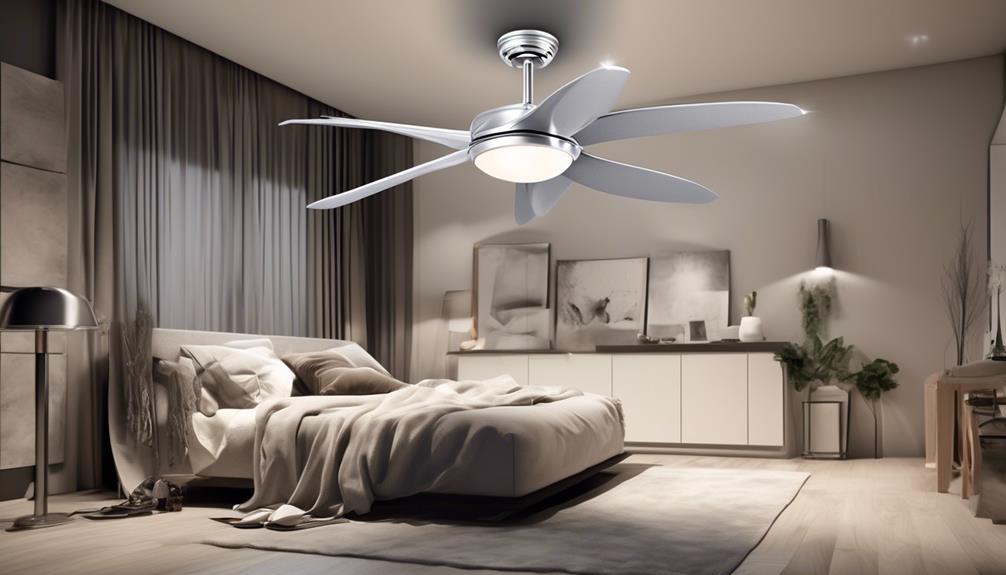
Have you ever considered whether the number of blades on a ceiling fan affects its performance? There is a popular belief that more blades result in better airflow, but is that truly the case?
As we explore the factors that influence the effectiveness of ceiling fans, we'll examine the impact of blade count on air circulation, energy consumption, noise level, and overall comfort.
By the end of this discussion, you might just rethink your assumptions about the ideal number of blades for your ceiling fan.
Key Takeaways
- The number of blades affects the air circulation efficiency of a ceiling fan.
- Fans with fewer blades tend to be quieter and more efficient in moving air.
- The blade count should be chosen based on the room size to ensure proper air movement.
- Consider personal design preferences and room decor when selecting the color and installation style of a ceiling fan.
Air Circulation Efficiency
We usually find that ceiling fans are most effective in improving air circulation efficiency when they're set to run counterclockwise during the summer months. This direction creates a downdraft, which produces a wind-chill effect, making the room feel cooler. Understanding airflow direction is crucial for maximizing the benefits of a ceiling fan. During the winter months, running the fan clockwise at a low speed can help redistribute warm air trapped near the ceiling, improving overall heating efficiency.
When considering air circulation efficiency, the material of the fan blades also plays a significant role. Most ceiling fans have blades made of wood, plastic, or metal. Each material has its advantages and drawbacks. Wooden blades, for example, are stylish and can provide a traditional aesthetic, but they may not be as durable as metal or plastic. On the other hand, metal blades are sturdy and easy to clean, but they can be noisier compared to wooden or plastic blades. Plastic blades are lightweight and often cost-effective, but they may not offer the same level of performance as wooden or metal blades.
Understanding the airflow direction and selecting the right blade material are essential factors in optimizing air circulation efficiency with a ceiling fan.
Energy Consumption and Cost

Investigating the energy consumption and associated costs of ceiling fans can help homeowners make informed decisions about their usage and potential savings. When considering the energy efficiency of ceiling fans, it's important to understand the long-term benefits and cost savings they can offer.
Here are some key points to consider:
- Energy Efficiency: Choosing a ceiling fan with an ENERGY STAR rating can significantly reduce energy consumption, leading to lower utility bills and cost savings over time.
- Cost Savings: Investing in a high-quality, energy-efficient ceiling fan may require a larger upfront cost, but the long-term savings on energy bills make it a financially wise decision.
- Environmental Impact: Opting for an energy-efficient ceiling fan contributes to a reduced carbon footprint and helps conserve energy resources, aligning with environmentally conscious choices.
- Long-Term Benefits: Energy-efficient ceiling fans not only provide immediate cost savings but also offer long-term benefits by extending the lifespan of the fan and reducing the need for frequent replacements.
- Smart Usage: Utilizing features such as adjustable speed settings and timers can further enhance energy efficiency and maximize cost savings.
Room Size and Blade Count
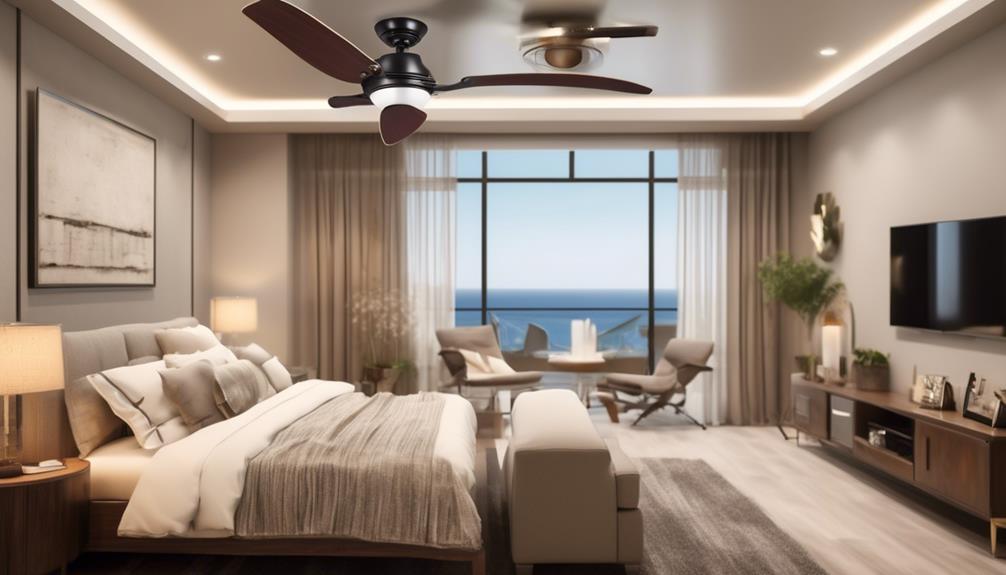
When selecting a ceiling fan, it's essential to consider the room size and the number of blades for optimal air circulation and cooling efficiency.
The size of the room determines the blade length needed for proper air movement. For rooms up to 75 square feet, fans with a blade span of 29 to 36 inches are ideal. Medium-sized rooms between 76 and 144 square feet require fans with a blade span of 36 to 42 inches. Larger rooms up to 225 square feet benefit from fans with a blade span of 44 inches or more.
Additionally, the number of blades on a fan can impact its performance. While more blades may seem more effective, it's not always the case. Fans with fewer blades tend to move air more efficiently and are generally quieter.
When considering the installation process, the number of blades can also affect the weight of the fan, making it easier or more challenging to install. Therefore, it's crucial to balance blade count with the room size and the installation process to ensure optimal air circulation and cooling efficiency.
Noise Level and Comfort
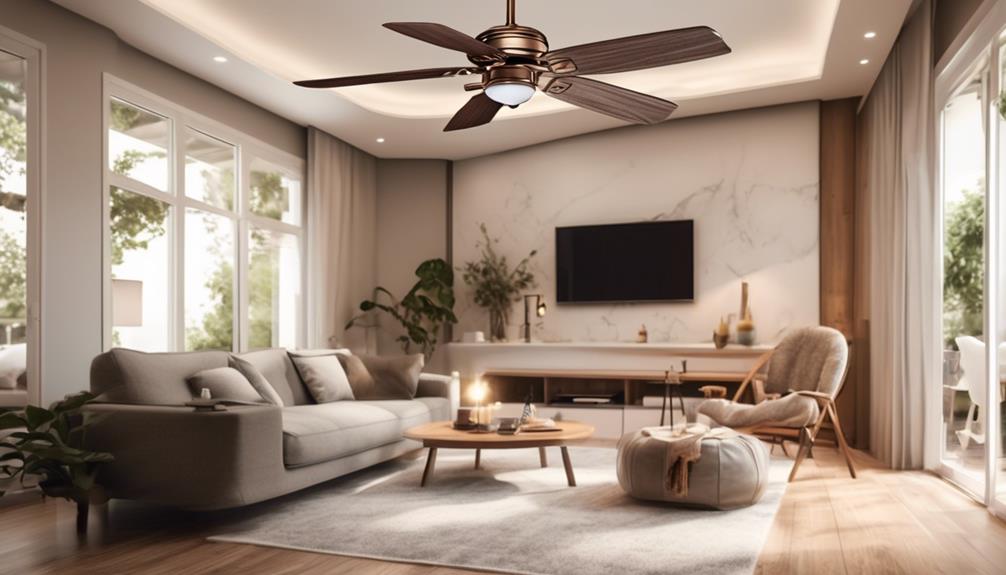
Considering the impact of blade count on fan performance, we can evaluate the noise level and comfort of the ceiling fan to ensure an optimal cooling experience in the room. When it comes to noise level, a ceiling fan with fewer blades tends to operate more quietly due to less air disturbance. This can significantly contribute to a peaceful environment, positively impacting sleep quality.
Comfort is also influenced by the fan's ability to circulate air effectively, which can be achieved with a well-designed 4 or 5 blade fan. Here are five key aspects to consider when evaluating noise level and comfort:
- Whisper-quiet Operation: A fan with fewer blades creates minimal noise, promoting tranquility in the room.
- Balanced Airflow: Optimal blade count ensures consistent and gentle airflow, enhancing comfort during hot days and nights.
- Improved Sleep Quality: Reduced noise level contributes to better sleep, enhancing overall well-being.
- Enhanced Relaxation: A quiet fan creates a serene atmosphere, promoting relaxation and comfort.
- Maximum Comfort: Proper blade count ensures an ideal balance between noise level and airflow, maximizing comfort in the living space.
Aesthetics and Design Preferences
Exploring various design options for ceiling fans allows us to enhance the aesthetic appeal of our living spaces while optimizing comfort and functionality. When considering aesthetics and design preferences, color options play a crucial role in ensuring that the ceiling fan seamlessly integrates with the overall decor of the room. Whether it's a sleek matte black finish for a modern look or a classic white for a more traditional feel, the color choice can significantly impact the visual impact of the ceiling fan.
Furthermore, the installation process is another aspect to consider when it comes to design preferences. Some may prefer a ceiling fan that seamlessly integrates into the ceiling without a visible downrod, creating a streamlined and minimalist look. On the other hand, others might prefer a more industrial or rustic aesthetic with a visible downrod for a statement piece in the room.
Considering these design preferences is essential to ensure that the ceiling fan not only complements the aesthetics of the space but also aligns with personal design preferences. By carefully selecting the color options and considering the installation process, we can elevate the overall design and functionality of our living spaces.
Frequently Asked Questions
Can the Fan Be Used in Outdoor Settings or Damp Locations?
Yes, the fan can be used in outdoor settings or damp locations. Our weatherproofing options ensure durability in these conditions.
Installation requirements are straightforward, making it easy to set up the fan for outdoor use.
The fan is designed to withstand the elements and provide optimal performance in outdoor environments.
Is the Fan Compatible With Remote Controls or Smart Home Automation Systems?
Yes, the fan is compatible with remote controls and smart home automation systems.
It's designed for energy efficiency and low noise levels, making it ideal for smart home integration.
Our product excels in remote compatibility and smart home automation, ensuring seamless control from anywhere.
Additionally, the fan's energy-efficient design and low noise levels enhance its performance, aligning with the demands of modern home automation systems.
Are There Options for Customizable Blade Finishes or Designs?
Are there options for customizable blade finishes or unique designs?
When it comes to blade finishes and designs, our fans offer a variety of customizable options, allowing you to personalize your fan to match your style and decor. The blade material is carefully selected for both aesthetics and energy efficiency.
Our fans provide a perfect blend of functionality and style, giving you the flexibility to create a truly unique and personalized fan for your home.
Does the Fan Come With a Warranty or Guarantee for Longevity and Performance?
We offer a longevity guarantee and performance warranty for our products.
It's essential to follow maintenance tips to ensure the fan's longevity and performance.
Additionally, our fans are designed with energy efficiency in mind. These features ensure that our fans not only provide optimal performance but also last for a long time.
We're committed to providing high-quality products that meet the needs of our customers.
Can the Fan Be Installed on Angled or Vaulted Ceilings?
Yes, the fan can be installed on angled ceilings and is compatible with vaulted ceilings.
The installation process for angled ceilings requires a special mounting kit, while for vaulted ceilings, an angled mounting bracket is needed to ensure proper installation.
It's important to follow the manufacturer's instructions carefully to ensure safe and secure installation on these types of ceilings.
Should I Choose a 3 or 5 Blade Ceiling Fan to Help Prevent Dust Buildup?
When deciding between a 3 or 5 blade ceiling fan, consider how the shape and angle of the blades affect air circulation. More blades provide better airflow, but also create more surface area for dust to collect. This is why fans collect dust, and why regular cleaning is important for preventing buildup.
Conclusion
In conclusion, whether we choose a 3 or 5 blade ceiling fan, we prioritize air circulation efficiency, energy consumption, room size, noise level, and aesthetics.
By considering these factors, we can maximize comfort and style while minimizing cost and environmental impact.
Ultimately, we seek the perfect balance of functionality and design in our ceiling fan choice.
- About the Author
- Latest Posts
Introducing Ron, the home decor aficionado at ByRetreat, whose passion for creating beautiful and inviting spaces is at the heart of his work. With his deep knowledge of home decor and his innate sense of style, Ron brings a wealth of expertise and a keen eye for detail to the ByRetreat team.
Ron’s love for home decor goes beyond aesthetics; he understands that our surroundings play a significant role in our overall well-being and productivity. With this in mind, Ron is dedicated to transforming remote workspaces into havens of comfort, functionality, and beauty.
Beginners Guides
Reset Carrier Furnace

As homeowners, we tend to overlook the convenience offered by our heating systems until they unexpectedly stop working. It can be annoying when our Carrier furnace breaks down, leaving us without heat. However, there are simple steps we can take to troubleshoot and possibly fix the problem.
In this discussion, we will explore the process of resetting a Carrier furnace, covering the common reasons why it may be necessary and the steps to take to get it up and running again.
So, if you've ever found yourself in the situation where your Carrier furnace seems to have gone on strike, stick around to discover the simple solutions to this common problem.
Key Takeaways
- Regular maintenance is important to prevent frequent resets of a Carrier furnace.
- Checking for power supply issues, such as tripped circuit breakers or loose electrical connections, is crucial.
- Performing a basic power cycle by turning off the power switch and allowing the system to restart can help troubleshoot errors.
- Accessing and using the reset button on the furnace's service panel is a step to take after addressing specific issues identified through error codes.
Understanding the Need to Reset
To understand the need to reset a Carrier furnace, it's essential to recognize the specific circumstances that may prompt this action. Understanding the reset process is crucial for maintaining the optimal performance of the furnace. One common reason for a reset is when the furnace experiences a sudden shutdown due to a power outage or a tripped circuit breaker. In such cases, resetting the furnace is necessary to restore its operation.
Importance of regular maintenance can't be emphasized enough. Neglecting regular maintenance can lead to issues that may require a reset. Accumulation of dirt and debris in the furnace components can cause overheating and automatic shutdown, necessitating a reset to resolve the issue. Additionally, irregular maintenance may lead to sensor malfunctions, which can also trigger the need for a reset.
It is important to note that while resetting the furnace may resolve immediate issues, it's imperative to address the root cause to prevent frequent resets. Regular maintenance, including cleaning, inspecting, and servicing the furnace, is vital to ensure its smooth operation and minimize the need for resets.
Checking for Power Supply Issues

When diagnosing issues with a Carrier furnace, it's crucial to first verify the availability of a consistent and adequate power supply to the unit. Here are the steps to check for power supply issues:
- Troubleshooting Thermostat
Ensure the thermostat is set to “heat” mode and the temperature is set higher than the current room temperature. Verify that the thermostat has power and the display is functioning properly. If the thermostat is battery-powered, replace the batteries to rule out power issues.
- Testing Electrical Connections
Turn off the power to the furnace at the circuit breaker. Check the furnace's electrical connections, including the power switch, circuit breaker, and fuse. Tighten any loose connections and replace any blown fuses. Use a multimeter to test for voltage at the furnace's terminal block to confirm the presence of power.
- Inspecting Power Source
Ensure that the furnace is receiving power from the electrical panel. Check the circuit breaker and reset it if necessary. If the furnace is connected to a power outlet, verify that the outlet is functioning by plugging in another device.
Performing a Basic Power Cycle
After verifying the availability of a consistent and adequate power supply to the Carrier furnace, the next step is to perform a basic power cycle to reset the system and potentially resolve any underlying issues. Performing maintenance on the furnace by carrying out a power cycle can help in troubleshooting errors and restoring the furnace to its optimal functionality. Follow the steps below to perform a basic power cycle:
| Steps | Instructions |
|---|---|
| 1. Turn off the power | Locate the power switch on the furnace and switch it off. Ensure that the furnace is completely powered down. |
| 2. Wait for 30 seconds | Allow the furnace to remain off for at least 30 seconds to ensure that all residual power is completely drained. |
| 3. Turn the power back on | After the 30 seconds have passed, switch the power back on. Wait for the system to fully restart and stabilize. |
Accessing and Using the Reset Button

We can access the reset button on the Carrier furnace by locating the service panel and removing it to reveal the reset button. When using safety precautions, it's important to turn off the power to the furnace before accessing the reset button to avoid any electrical hazards.
Here's how we can access and use the reset button:
- Locating the reset button:
- With the power off, locate the service panel on the furnace.
- Remove the screws or fasteners holding the panel in place.
- Once the panel is removed, the reset button should be visible near the burner assembly.
- Identifying error codes:
- Before pressing the reset button, it's crucial to take note of any error codes displayed on the furnace's control board.
- Refer to the furnace's manual to interpret the error codes and understand the underlying issue.
- Resetting furnace operations:
- After identifying and addressing the issue indicated by the error codes, gently press the reset button.
- Turn the power back on and observe the furnace to ensure that it restarts and operates normally.
Troubleshooting Common Reset Problems
To troubleshoot common reset problems with the Carrier furnace, understanding the possible issues indicated by error codes is essential for effective resolution.
One common issue is a dirty air filter, which can restrict airflow and cause the furnace to overheat, triggering a reset. To address this, turn off the furnace, replace the filter, and reset the system.
Another frequent problem is a malfunctioning thermostat, leading to inaccurate temperature readings and improper furnace operation. Troubleshooting techniques for this include checking the thermostat settings, replacing the batteries, and ensuring it's correctly wired.
Additionally, clogged condensate lines may cause the furnace to shut down and require a reset. To resolve this, inspect the lines for blockages and clear them if necessary.
Furthermore, issues with the flame sensor, gas supply, or electrical connections can also lead to reset problems. Troubleshooting these requires inspecting and cleaning the flame sensor, ensuring the gas supply is uninterrupted, and checking for loose or damaged electrical connections.
Frequently Asked Questions
Can I Reset My Carrier Furnace Without Turning off the Power Supply?
We can't reset a Carrier furnace without turning off the power supply. However, for maintenance tips and troubleshooting, it's essential to ensure the power is off to prevent electrical hazards.
To improve energy efficiency, consider adjusting thermostat settings and scheduling regular maintenance. This can help identify any potential issues early, ensuring the furnace operates efficiently.
Always prioritize safety and follow the manufacturer's guidelines when performing any maintenance or troubleshooting tasks.
What Should I Do if the Reset Button on My Carrier Furnace Is Not Working?
If the reset button on your Carrier furnace isn't working, troubleshooting reset issues involves checking for any obstructions or damage.
One alternative to the reset button is to power off the furnace at the breaker switch for a few minutes and then switch it back on.
If the issue persists, it may be necessary to consult a professional technician to diagnose and repair the problem.
How Often Should I Need to Reset My Carrier Furnace?
We perform regular furnace maintenance to ensure the heating system functions optimally. This includes troubleshooting for any issues that may arise.
It's crucial for energy efficiency and to prevent frequent resets. Proper maintenance helps identify and address any potential problems before they escalate.
Will Resetting My Carrier Furnace Affect Any of the Settings or Programming?
Resetting the Carrier furnace won't affect thermostat settings or programming. However, it's crucial to ensure that maintenance is up to date to maintain energy efficiency. If you're troubleshooting issues, resetting the furnace can be a step in the process. Always refer to the user manual for specific instructions.
Regular maintenance and attention to thermostat settings are key to ensuring the system operates at its best.
Is There a Specific Time of Day That Is Best for Resetting My Carrier Furnace?
The best time for resetting a Carrier furnace is during periods of low energy demand, such as early morning or midday. This can help optimize energy efficiency and minimize temperature impact on your home.
It's also an ideal time for equipment maintenance and troubleshooting as it allows the system to recalibrate without disrupting regular usage patterns. By performing resets during these times, you can ensure optimal performance and minimize disruptions to your temperature control.
How Can I Reset My Carrier Furnace If I See Three Bars on the Dyson?
If you see three bars on the Dyson f three bars, it means there is a communication error between the thermostat and the furnace. To reset your Carrier furnace, locate the reset button on the furnace’s control panel and press it. Wait a few minutes before turning the furnace back on.
Conclusion
In conclusion, resetting a Carrier furnace is a simple yet crucial troubleshooting step for resolving issues with the system. By following the steps outlined in this article, you can easily identify and address power supply issues and reset the furnace to restore it to proper functioning.
Remember, when in doubt, 'don't throw the baby out with the bathwater' – take the time to troubleshoot and reset before considering more drastic measures.
- About the Author
- Latest Posts
Introducing Ron, the home decor aficionado at ByRetreat, whose passion for creating beautiful and inviting spaces is at the heart of his work. With his deep knowledge of home decor and his innate sense of style, Ron brings a wealth of expertise and a keen eye for detail to the ByRetreat team.
Ron’s love for home decor goes beyond aesthetics; he understands that our surroundings play a significant role in our overall well-being and productivity. With this in mind, Ron is dedicated to transforming remote workspaces into havens of comfort, functionality, and beauty.
-

 Vetted3 weeks ago
Vetted3 weeks ago15 Best Contact Paper for Kitchen Cabinets to Elevate Your Home Decor
-

 Vetted1 week ago
Vetted1 week ago15 Best Poe Cameras for Home Security – Reviews & Buying Guide
-

 Vetted4 weeks ago
Vetted4 weeks ago15 Best Leather Restorer Products to Revive Your Furniture and Accessories
-

 Vetted3 weeks ago
Vetted3 weeks ago15 Best Drain Snakes to Unclog Your Pipes Like a Pro
-

 Beginners Guides5 hours ago
Beginners Guides5 hours agoI Inhaled Vinegar Fumes
-

 Vetted3 weeks ago
Vetted3 weeks ago14 Best Stationery Brands for Your Next Writing Adventure
-

 Beginners Guides2 weeks ago
Beginners Guides2 weeks agoSwinger Porch Light Color
-

 Mardi Gras Decoration3 weeks ago
Mardi Gras Decoration3 weeks agoWhy Does Hobby Lobby Not Do Mardi Gras?



















